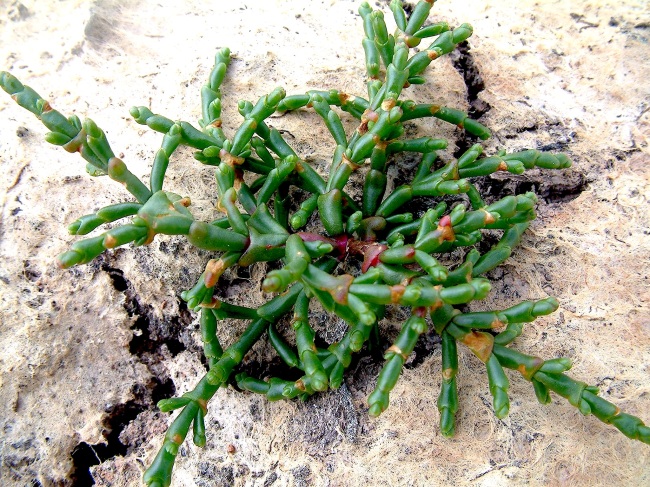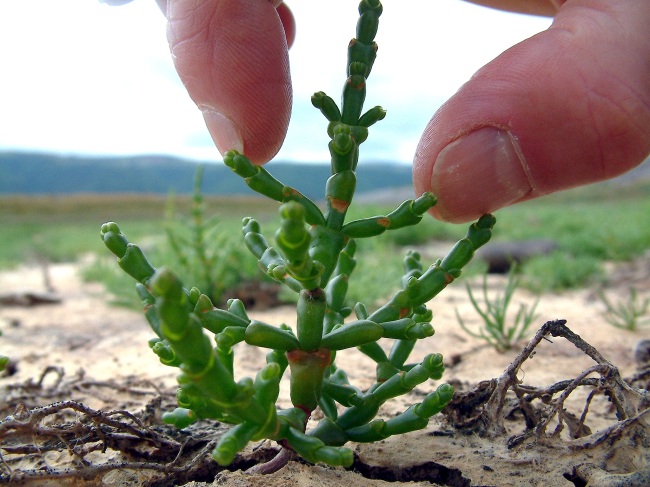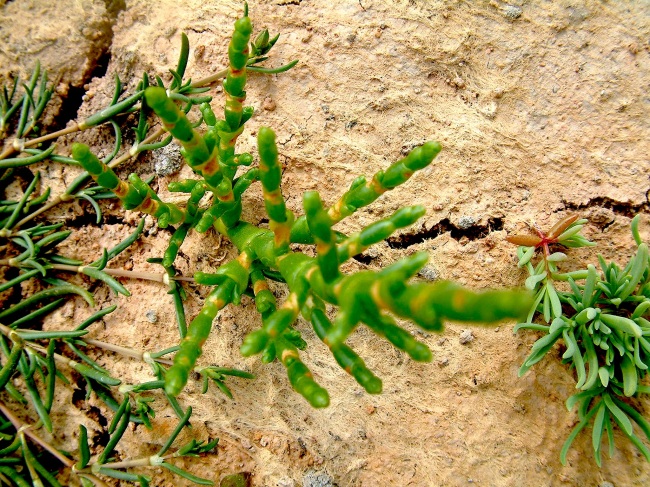Samphire Is One of My Favourite Seasonal Foods
by martinhesp
There was a glint of green in the fishmongers’ – that was all it took for me to do a double take while wandering through a Westcountry harbour town the other day. When you see the colour green lurking on a fishmonger’s slab, it can only mean one of two things – either the shopkeeper has jollied the place up with a bit of seaweed, or he has pulled off a masterstroke and is selling samphire.
Shakespeare mentions this most delicious of wild food – which is in season now – in King Lear: “Half-way down, hangs one that gathers samphire; dreadful trade!” he says – but by the sound of it the Bard was referring to rock samphire, (Crithmum maritimum) which grows on many a Westcountry cliff. I have to admit that I’ve never eaten it, but know you can and would love to hear from anyone who has. 
The type I like best – and certainly pick most often – is marsh samphire (Salicornia europaea), sometimes known as glasswort. When you see it sprouting in the wild it looks a bit like a miniature desert cacti. Samphire however, grows in wet places – you will find it sprouting in many salt marshes in late June.
This fishmonger told me his came from France. “From the Somme actually,” he told me. “The same place where they had the big battles in World War One. In fact, we had one old man come in who remembered eating it in the trenches. We’ll be getting it over from now until the beginning of September.”
Other fishmongers in the UK have picked up on the delights of samphire too, and my recommendation is to buy it if you see it. It is, quite simply, one of the most delicious vegetables around. Having said that, I find it almost impossible to describe its flavour and texture. The closest I can get is to say that it’s a bit like salty asparagus served in a crunchy jelly that has bite – if you can imagine such a thing.
You don’t have to go to the Somme or to the fishmongers’ to sink your teeth into this heavenly veg – but I would plead with potential pickers to be most careful when harvesting the wild crop of samphire. Much of it will be growing in designated nature reserves – or Sites of Special Scientific Interest – and in the UK you can be fined up to a eye-watering £20,000 if you are caught damaging plants within such an area.
However, it is perfectly possible to pick a few of the young bright green shoots when they are just a few inches high without harming the plant. The best way to do this is to take along a pair of scissors and snip off a few of the upper shoots. You will need plenty of patience to gather a worthwhile load, but it’s pleasant to be out on the side of an estuary at this time of year – and what’s the hurry anyway?
People have been harvesting samphire for centuries in estuarine areas without killing off local stocks. Samphire is high in sodium carbonate and was given its old name, glasswort, because vast quantities of it were used in glass manufacturing. In days of yore it was much easier to release sodium from samphire than from pure salt – until a man called Leblanc invented process of obtaining it from sodium chloride in the early 1800s.
Samphire also used to be mixed with animal fats and used in the soap-making industry. Traditionally, the low salty fenlands of eastern England provided the nation’s main samphire areas, but it has always grown happily in the isolated creeks and saltings of the Westcountry. For samphire lovers, these places tend to be as secret and jealously guarded as prime mushroom picking spots. 
Whether you pick or buy samphire, you must wash it, making sure any sand is cleaned away. I then steam it briefly – for a minute at the most – before tossing it in a bowl with butter, black pepper and several squeezes of lemon. You will not need any salt, because samphire comes ready-salted – but it does seem to have a wonderful affinity with freshly ground black pepper.
I am quite happy to eat the stuff served like this on its own with a hunk of good brown bread and butter, but if you really want to impress your friends, flash-fry fillets of sea-bass, mackerel or red mullet and place them artistically upon a pile of the peppered and lemony samphire.
This simple dish will have cost you next to nothing, but it will look like something that has come straight from the kitchens of a Michelin chef.
Samphire ISN’T mentioned in my Cornish Snapper books – but it should be because the press-photographer who solves the cases in the Spinning Pilgrim and in the Feuding Fisherman supposedly lives near Hayle, five minutes walk from an excellent saltings where you can pick the stuff.
http://www.amazon.co.uk/Cornish-Snapper-Feuding-Fishermen-ebook/dp/B00AGFNP38

